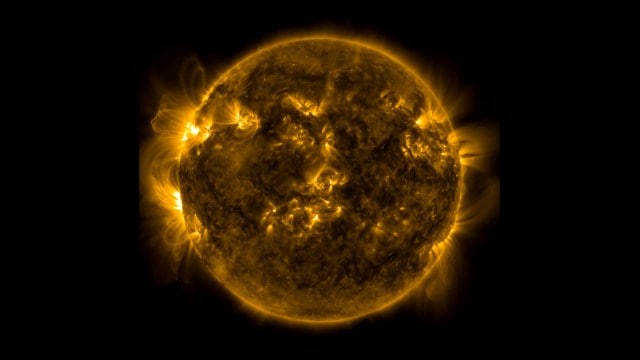- India
- International
4 flares erupt from Sun in rare celestial event: How will it affect Earth?
Current solar activity points to the Sun likely nearing or reaching the peak of its 11-year solar cycle known as solar maximum.
 Screenshot of video of Sun taken by NASA’s Solar Dynamics Observatory. (X/@NASASun)
Screenshot of video of Sun taken by NASA’s Solar Dynamics Observatory. (X/@NASASun)Four solar flares erupted simultaneously on April 23 in a rare celestial event, possibly heralding in the Sun’s dynamic 11-year cycle.
The sight of “sympathetic solar flares” in different regions of the star was captured by NASA’s Solar Dynamics Observatory, according to Weather and Radar, showing complex magnetic interactions.
The four-part eruption began around 1 am EDT on Tuesday (April 23), originating from three sunspots and a large magnetic filament, according to LiveScience. Each of the blast sites were separated by hundreds of thousands of miles and the area between them covered around a third of the solar surface facing Earth.
The concurrent blasts were part of one single eruption, known as a sympathetic solar flare.
What are sympathetic flares?
Sympathetic flares are caused by multiple eruptions across the Sun’s magnetic field, linked by massive magnetic field loops that lie above the solar surface. When one spot detonates, others follow suit. This leads to coronal mass ejections (CMEs) and massive bursts of plasma.

Such solar activity is likely an indication of the Sun reaching the peak of its 11-year solar cycle known as solar maximum. The peak is marked by increased solar events like flares and CMEs.
As scientists continue to monitor the event and its aftermath, the event offers a peek into understanding the Sun’s complex life cycle.
This is the third sympathetic solar flare this year, following a pair of explosions in January and a duo of X-class flares in March.
Why is this event rare?
Most sympathetic flares reported so far include two linked flares, ranging from small outbursts to X-class flares, the most powerful class of solar flares the sun can produce.
The emission of four flares in unison makes this event “super-sympathetic”, according to Spaceweather.com
How can they impact Earth?
If directed towards the Earth, they have the potential to disrupt power grids, telecommunication networks and orbiting satellites and expose astronauts to dangerous doses of radiation, according to space.com. Minor class G1 geomagnetic storms around April 25 and April 26 could also illuminate skies at lower latitudes with auroras.
More Tech
May 08: Latest News
- 01
- 02
- 03
- 04
- 05






























